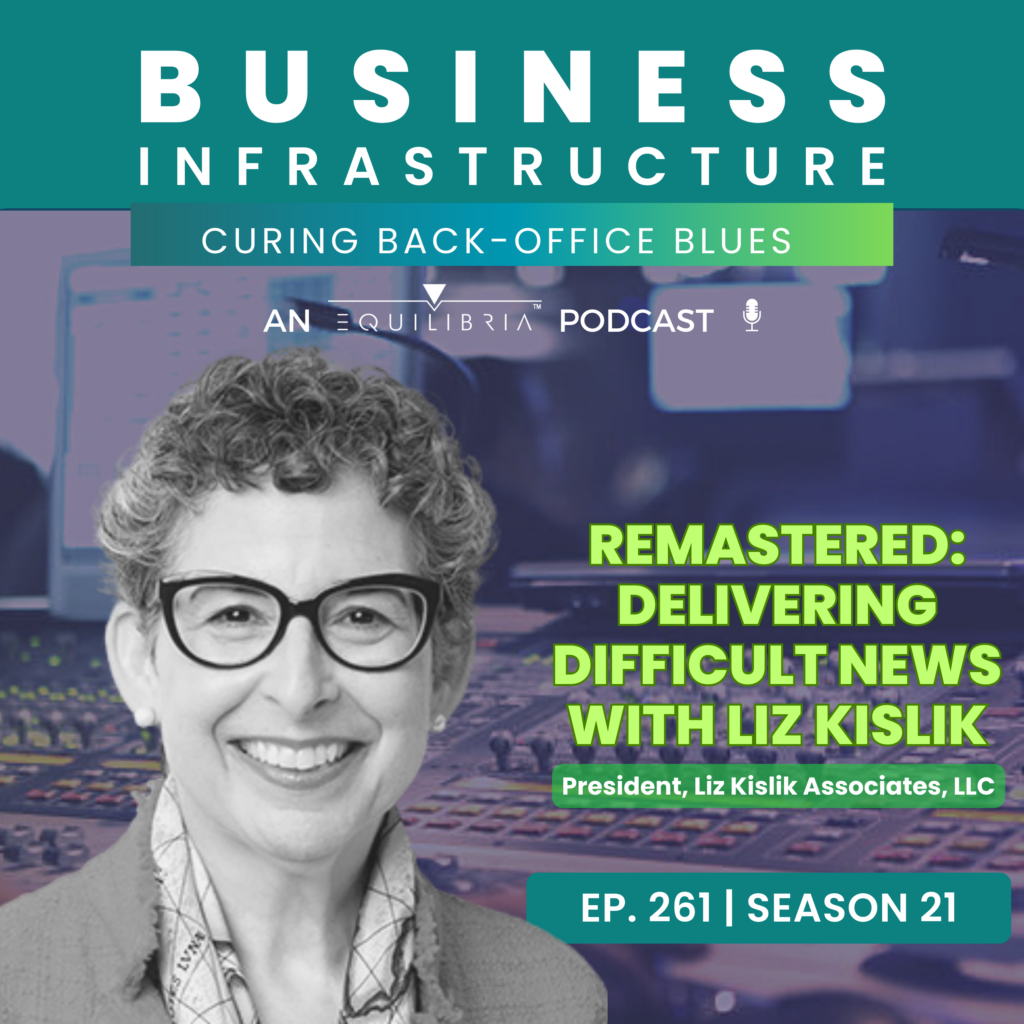Transcript
This podcast is brought to you by Equilibria, Inc. We design business infrastructure that scales the operations of fast-growing small businesses to the next level.

Welcome to Season 21 of the Business Infrastructure podcast. This season is unique in that we’ve combed through our catalog of episodes to curate a list of oldies but goodies. These are episodes that did extremely well when promoted on social media and generated some great conversations, and friendships.
It’s hard to believe but this show has been around for five years and if you’ve been following us since the beginning, then you know how much the format has changed. The production quality is much better and with that in mind, we’ve decided to remaster episodes for this season. The original content of these episodes was so good that it deserves to be remastered to fit our new format.
So, with that in mind, our first episode this season features someone who I immediately connected with following her original interview in 2019.
We talked about the fact that businesses expand and contract. It’s often inevitable. And sometimes streamlining operations may mean cutting labor expenses or something else that could have a devastating impact on your team. It’s hard enough being the bearer of bad news, but as you’re about to learn it’s not what you say, but how you say it.
This is Episode 261 – Delivering Difficult News with Liz Kislik
As our companies operate through growing pains and growing spurts, developing effective communication skills is a must. As the founder and CEO at Liz Kislik & Associates, Liz is a pro at this! Let’s hear from her directly about what she does best.
Thanks, Alicia. I’m so happy to be with you.
I work with companies that are experiencing growth or change or actually being stuck and not being able to generate the growth or change they’re looking for. And I work with people at every level of the business, depending on the issue, and learn a lot about what actually happens there. And therefore, I’m able to come up with solutions or to facilitate discussions that they’re not comfortable having on their own.

Don’t let Liz’s modesty fool you. She’s a frequent contributor to the Harvard Business Review as well as Bloomberg and her client list reads like a Who’s Who. It includes companies like American Express, Sax Fifth Avenue, and Warner Brothers. Considering the impressive diversity of her clientele, one thing is clear – delivering difficult news is a universal issue regardless of industry. I asked Liz if she could distill it down to one thing.
I tried to think about how to encapsulate this and, and here’s where I ended up.
It’s not a one-way or one-step process. And that’s because everybody’s different and everybody will absorb or not absorb what you’re telling them differently. And whatever they take in will not match exactly the things you planned or what you meant.
Considering that delivering difficult news is not a one-step process, I thought it might be helpful to ask Liz to offer advice based on a common example of what happens to us small business owners. As we begin growing, we often realize that the people who started with us do not have the skills required to help take our businesses to the next level.
We need new team members who have the skills we’re looking for. And, well, that’s where things can get a little dicey. People are an integral part of building sustainable business infrastructure, but often, during fast growth, we don’t allow proper time to communicate the need for staffing changes.
Part of why they don’t is because they’re dealing with what’s in front of them. And so instead of dealing with this question just as the next thing, I want to give you a little bit of backdrop so your listeners have a way of thinking about these issues because difficult news, there are all kinds of difficult news, but it can be difficult in different ways.
And I just want to give you three general categories first, because your example actually hits all of them. It’s a complex example. And, and I’ll show you how. So, in the first place, you might have, a relatively simple, straightforward category in which the difficult news is that you have to say no to someone. You have to disappoint someone. And that could be that you can’t give them the resources they want, or you can’t meet their preferences in some way. So, disappointment is the thing that’s likely to follow in the second big category.

The hard news may actually be something that’s very good for the business, but it creates change or disruption for people as they go about their day-to-day duties, the things that they’ve been used to doing, everything they’re comfortable with. So even though there is a good end to it, it feels terrible when you hear it.
And then the third thing is a kind of explicit negative impact. There’s a problem with you, there’s something going wrong in your area, or our top customer doesn’t wanna work with you anymore. Something that is right away, like a big slap in the face and it’s about the business, but it’s explicitly about the person too, so the situation you raised we’re past the immediate startup stage. We built the startup on people we know and may actually hold dear. But then to move the business further, we think we’ve got to bring in people with more expertise, specialization, rank in some cases, that kind of thing. Is that accurate?
Yes.
Okay. There is a real difference between having to bring new people in because you’re growing so fast that the people you have just can’t handle it. There have to be new people, or the business will stall. Versus bringing in a new person, because you haven’t been able to get us to the point we need. The first case, that’s the kind of thing where that hits all the bells of my three categories. So, the person who’s already there may be disappointed, don’t you think I can do the bigger level thing they’re disrupted, I’m going to have to get used to a new person here.
And we were so comfortable the way that we were, and they may feel that there’s an explicit negative impact because this is going to change my relationship to the job and the business. It’s going to change the way I spend every day. I’m really going to hate this. Whereas in the second case, there’s a little of one and two, but it’s really all three, you weren’t enough.
And so, we need this stranger. So that’s really painful, painful both to the person who has to hear it and often to the person who has to deliver it.
What a great point! And it’s a natural segue to the next question – what about another element of business infrastructure, processes? Is there a proven process for delivering difficult news? Turns out, the answer is yes!
The announcement is only the middle stage of the process. I look at it as a three-stage process. The first stage is preparation, and that’s really in the measure twice, cut once a school, think about it, and plan for it deeply because it’s not going to work the way you expect anyway. But at least go through what the various kinds of responses might be. and think about how you can cushion a blow, show that there’s more upside, and figure out which details should be explained now and which later. So, there’s a whole bunch of prep that’s stage one in the process.

Stage two of the process for delivering difficult news is the actual delivery, which, Liz points out, is likely going to take place over multiple conversations, not just one.
And you know, we all take in information in different ways. So, every business has people who do better in a face-to-face meeting where they can ask questions, even if it’s on video.
Whereas some people actually do better if they can read an announcement, figure out all their questions in private and then come back, that kind of thing. And there are some people who really need to hear the message in person and in an email and in the little weekly memo you send to everybody, they need it 12 ways, 47 times. So, you’ve got a really big range in what the delivery might need to be. And then of course there is the interaction or the language itself. So, delivery is very complex.
After the actual delivery of the difficult news comes the third stage – follow-up.

The fact doesn’t mean things will change from their end. The fact that they now know is sort of the start of their process. You’ve been thinking about it and working on it and figuring out how to get to this conversation, and you kind of feel like now you’re handing it over to them but that doesn’t mean they’re opening the package. So, there’s a bunch of work that you need to do afterward to check for damage and help with recovery if their recipient is upset, to keep explaining it if they don’t understand it completely, and to check on how it’s going once they start the process.
As I’m listening to you talk about these three stages, preparation, delivery, and follow-up. I can’t help but think. This is a lot of work because there are so many different ways that you can communicate or deliver a message. What are some of the different tools that we can use to communicate messages or deliver, for lack of a better word, bad news?
You are spot on, Alicia because it does take more time and more time than anybody gives it. And that’s why we usually end up with a mess. Most of the time these kinds of conversations are disruptive. People get defensive sometimes or resistant, you can just imagine the crossed arms and the head down and the rolling back in the chair.
You know, all of that kind of stuff. And in many organizations, you then get either overt or covert resistance after the fact. In the example you gave at the beginning of our discussion, maybe what happens is that the incumbents don’t reach out to the new person, explain the facts of life to them, tell them, which place has the good coffee. Explain to them this is how we deal with client A versus how we deal with client B.
They can actually withhold and create a really rough time for that new person. And they may not think of it as sabotage, but that’s the impact.
That’s the impact, indeed. And sadly, I’ve seen this play out with many small businesses I’ve worked with over the years. Another observation I’ve made is that although there are many ways to deliver or communicate difficult news, the way it is delivered also depends on you as the person delivering the communication. To that extent, having the right tools, which is the third and final element of business infrastructure, can make or break your messaging.
Yes, and the first tool I want to suggest is because much of this is not tool-based, it’s more practice-based. But one of your best tools, if you are a leader and have to have a challenging conversation, is actually your calendar. This is so not intuitive, and it’s only because of years of this that I see it’s the case because of exactly what we talked about before. You never put in enough time, and you always think you can just say it.
And some of us are avoidant and we don’t like to say it. So, we think, Well, if we wait till the last possible minute and say it as small as possible, then we’re done. You know but if you actually treat the conversation the way you would a pitch to funders or to a client and put in the time and put it on your calendar, you have, you may have to call it something else, but you need thinking time to plan how you’re going to do this.

And you need time with the individuals, and then you need recovery time. So, I strongly recommend the use of the calendar because then you make yourself responsible to yourself to actually see the thing through. Now, in terms of the message itself and how to deliver it and, and what are the best ways, anything that is a challenge for the recipient, if there is any way to start in person, I strongly recommend that what’s at issue here is the relationship and how are we managing both the managerial and
interpersonal parts of that relationship. And that’s done best in person. And even if you have to do a kind of all-hands meeting and make a general statement and tell them that after this meeting, I’m going to meet with each of you individually to discuss how this will affect you personally. That’s fine. That’s a wonderful flow. In fact, one of the very important things about this, and something to put back on your calendar, if there is a level between you and the person who really needs to hear whatever this is, you have to first talk to the person in between and make sure that they are on board.
Because more things get screwed up because the intermediary managers or decision makers are not fully aligned, then even what goes wrong between the senior person and the junior person. They can stop an initiative dead in its tracks, not necessarily intentionally, but if they’re not aware, or not informed, the way they will talk about the issue will not match the way the senior leader talks about it. So that’s really important. And you know, we usually think, Oh, they’ll just understand, of course, they’ll understand their businesspeople. It’s a business issue. They will understand. Forget it! Everybody needs personal attention.
So, face-to-face is the best. And part of why it’s the best is because you have the advantage of your body language as well as whatever you’re verbalizing. And they can see if you yourself are comfortable and if you look straightforward and the way you usually do, and if you are open to them versus if you are nervous or seem to be in some kind of defensive crouch, it’s tough.
It is tough and to Liz’s point, it requires a lot of skill to not only deliver the message but to go through the three-stage process she previously described. Using your calendar isn’t the only tool Liz recommends. There’s a lot more. And you’ll discover those additional tools when we come back from the break.
In the world of business, success isn’t just about great ideas or products. It’s about having a strong foundation—a solid business infrastructure. But why is it so important? A robust business infrastructure is like the backbone of an organization. It provides the necessary support for all our operations. Business infrastructure ensures effective communication and collaboration. It allows teams to seamlessly share information, work together efficiently, and make informed decisions.
It also enables efficient data management. With proper systems in place, businesses can securely store, analyze, and utilize their data to gain valuable insights and make strategic decisions.
Thirdly, a strong infrastructure promotes innovation and growth. It provides the flexibility to scale up operations, adopt new technologies, and adapt to changing market demands. It’s no wonder why a solid business infrastructure is essential for success. It enhances communication, facilitates efficient data management, fosters innovation, and enables flexibility—all vital for businesses to thrive in today’s competitive landscape. Invest in a strong business infrastructure, and watch your business reach new heights.
At Equilibria, we’re excited to offer a free webinar opportunity where we’ll do a deep dive into business infrastructure. Stop being a victim of unmanageable fast growth and start building your own company’s business infrastructure. Don’t wait! Experience the order and calm that thousands of other small businesses have. Sign up now at SmoothOperator.Club. That’s SmoothOperator.club.
We’re back and before the break, management consultant Liz Kislik shared some strategies to help us deliver difficult news. As promised, she has some additional tools to share with us to navigate potentially treacherous communication waters. Here’s Liz.
I’m going to stick to some that I think will be helpful in this case, and also by extension in conflict resolution. One set of tools that’s extremely helpful has to do with self-management. Whoever is delivering the hard news has to be calm and confident enough while remaining themselves that it helps the other people feel as safe as they can. and reassures them that we’re not falling apart here. This is a change. It’s not the end of the world.

And there are all kinds of, self-management, emotional intelligence, and self-awareness tools. I like, a bunch of different things. And everybody, this is what I keep saying over and over. I’m sorry to be beating this drum – everybody’s different. So, everybody will like different things. But there’s physical self-management and I’m sure plenty of people have seen Amy Cuddy’s TED talk that talks about power poses. I think those can be very valuable. anything that helps you be your most physically confident is important.
Similarly, you need techniques for calming yourself internally. We all have chatter going on. You know, there’s practically a committee meeting in our heads all the time, and so there are a variety of things that are helpful there.
One is just any form of meditation, particularly mindfulness meditation. And there are so many. Deepak Chopra has all kinds of stuff. There are apps. There’s one called Headspace. There’s one called 10% Happier, that people can check out. And then there are specific kinds of practices that are great if you are feeling bad either before or after the process. There’s one by Tara Brack, b r a c h, with the four initials, R.A.I.N – rain. And there’s also a great book by a woman named Christine Neff, n-e-f-f.
And that’s on self-compassion. And there are useful practices in all of these things that help you strengthen yourself so that you can be simultaneously authentic and on point when you have to deliver. And then you can recover afterward.
In case you’re listening and thinking to yourself that this sounds like a bunch of soft-skill fluff, then Liz has some words of advice specifically for you. Not heeding her advice could easily lead to a disgruntled team member who wants to exact revenge.
So in case any of your listeners fall into that camp, let me give a more realistic example. And by that, I don’t mean that your example doesn’t happen, but that statistically, here’s one that happens a lot more, which is that the leader doesn’t handle it well. The change happens in a forced brutal kind of sense. And it reverberates through the place for years after the person who was most deeply affected is never the same again, whether they stay or whether they’re gone. And their colleagues also learn that this is not a
safe place.
So, if people want evidence, there are all kinds of neuroscience and statistical data and financial data about the negative impact when people are treated badly or feel unsafe versus when people do the work to manage themselves. Because you can do all the meditation in the world and still mess up a conversation because conversations are hard. And then you have to have the courage and the spine not to be tough, but to go back and say, I didn’t handle this perfectly. I’m sorry when I said these things. I did not mean to indicate those things. And I wanna make sure you understand both what my intent was and what we need to do now to go forward, and I hope you will come and play this game with me.
So, the good thing about it, interestingly, is if you don’t behave terribly, you can always go back. If you behave terribly because you didn’t care, what comes across is the fact that you didn’t care. And then you can go back, and people may listen to you because you have the power and authority, but in the long run, whether or not you can see it, it may have been better for your business. You could still be making money hand over fist, but maybe it would’ve been more. You end up leaving something on the table, or some of it is scraped away even if you don’t see anything drastic.
What a great way to summarize all of that. And, there’s so much more that I wish I could ask you, but unfortunately, we are running out of time. I imagine that your calendar stays booked, because of the type of work that you do. How can people get in touch with you?
The best way is really to go to my website, LizKislik.com. And part of what may be useful is there I have a free, hand-field guide and, checklist about how to manage certain kinds of interpersonal conversations that may be useful. And also, there are my weekly blogs and, there’s a monthly newsletter so folks can get access to all kinds of useful information for free. And they can of course find me on LinkedIn and on Twitter.
Awesome. And I did want to ask you also about your TED Talk. Can you talk about that for a little bit, please?

Oh, sure!
That’d be great.
So, the talk is really about the fact that we think conflict is something that happens between people, and it certainly does, but it only gets to that point. in most cases, serious conflict comes up because there are other things that are going wrong that are not the people that are structural or procedural or historical. The people are manifesting it, and it’s the parts you see, it’s the people who are complaining.
The computer system isn’t complaining, so you don’t know that underneath all these complaints, there’s really something wrong with that system, which needs serious work. And in the talk, I go through sort of five stages that you can work through to start improving circumstances so that people don’t have to feel so at each other’s throats anymore. that have to do with making sure that there isn’t really just a bad person or a wacky person who’s stirring up the whole sense of stuff. And then gathering the right data so you know what’s actually happening.
And then getting people’s agreement to proceed with a solution and making sure, just sort of like what I said before, that you have people all through the organization who are signed on to help make the solution work. And then you do have to teach some new techniques for interaction specifically, so people don’t fall into old bad habits. And if you work on all those things, you actually move the entire group forward, not just about the conflict at hand, but in how they deal with each other in general.
And having that kind of a unified front is golden! It reminded me of an article I read on Liz’s website entitled, “How to Shift from Asking for Trust to Being Trustworthy.”
It’s been really lovely speaking with you.
Okay, so back in the day when this interview was originally recorded, I used to give summaries at the end of an interview. It all happened live, with no pre-recorded voiceovers. Just pure ad-libbing. I strayed away from doing that, but I’m strongly considering incorporating that feature again. Listen up because what you’re about to hear is that original end-of-interview summary.
As a reminder, she said that the one thing we need to know about delivering difficult news is that it is never a one-way or one-step process. That’s because everyone will absorb the information that you have to deliver differently. You may just have to alter a message based on the type of news that you’re delivering, as well as the relationship that you have with that person. Liz actually gave us three categories for why it can be difficult to deliver or why it can be interesting, I should say, in delivering difficult news in different ways.
The first category was that you have to actually say no to someone, and that can lead to disappointment for the recipient of the news that you have to deliver. The second category is that the hard news may be something that’s good for the business, but it may actually cause disruption again for the recipient of that message.
And the third category is that it can have an explicit negative impact on the person that you’re communicating this news. The implication is that there’s a problem with you. Liz also talked us through some of the people, the processes, and some tools for delivering difficult news. When it came to people. She said that there are two things that we need to take into consideration as we’re going through growth spurts. It could be that we’re bringing in new people just to be able to handle the volume.
It could also mean that we’re bringing in new people because the existing people that we have simply can’t perform to the level that’s required from a process perspective. She actually told us that there are three stages to take into consideration: the preparation stage, and the delivery stage, where you are actually announcing or delivering the news. As well as that follow-up stage.
You have to allow time to check for recovery from the message that you may have just communicated. That was really important because as Liz mentioned, one of the most important tools that you can have in delivering difficult news is in fact your calendar. You have to take time to plan how you’re going to deliver the difficult news, deliver the news, but also allow for that recovery period as well. And as a wrap-up, she said, at the end of the day, everybody needs personal attention, so be careful how you treat people. People can’t deliver trust on demand.
If you don’t take the time to carefully craft your messaging and deliver it, you can end up leaving a lot of money on the table. If you’re going through a growth spurt or you’re having some type of a shakeup in your management, or you may even be going through a transformation initiative at your company, contact Liz so that you and your team can get refocused and back on course.
Now that you’ve heard that summary, let me know what you think. Feel free to leave a comment wherever you’re listening to this episode. You can also access the resources Liz mentioned at BusinessInfrastructure.TV. Again, that’s BusinessInfrastructure.TV. Thank you for listening! If you enjoyed this episode, then please subscribe and leave a five-star rating and review.
Stay tuned for our next remastered episode. It will feature another management heavyweight.
As always, remember to stay focused and be encouraged. This entrepreneurial journey is a marathon and not a sprint.
This podcast was written, produced, and narrated by me, Alicia Butler Pierre. Audio editing by Olanrewaju Adeyemo. The original score and sound design by Sabor! Music Enterprises.
This is the Business Infrastructure – Curing Back-Office Blues podcast.

















